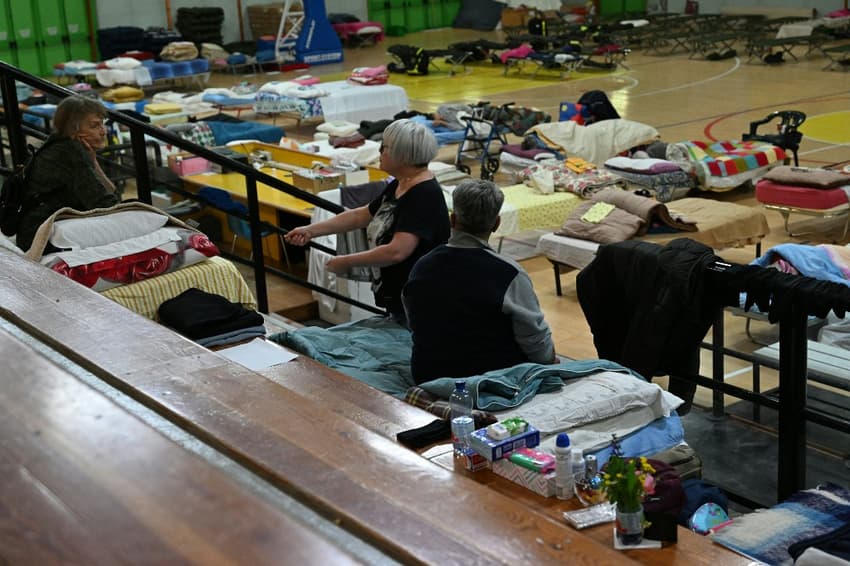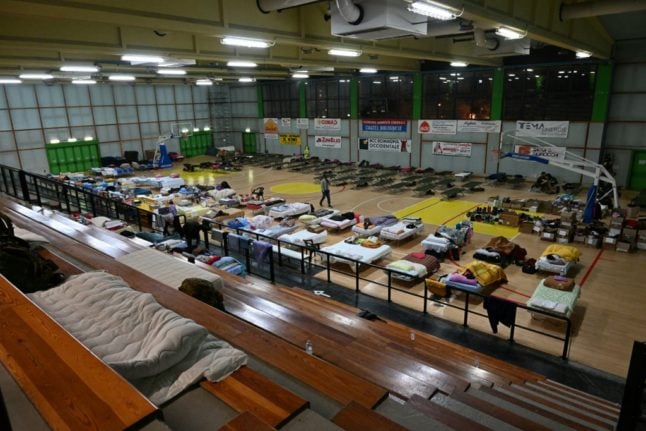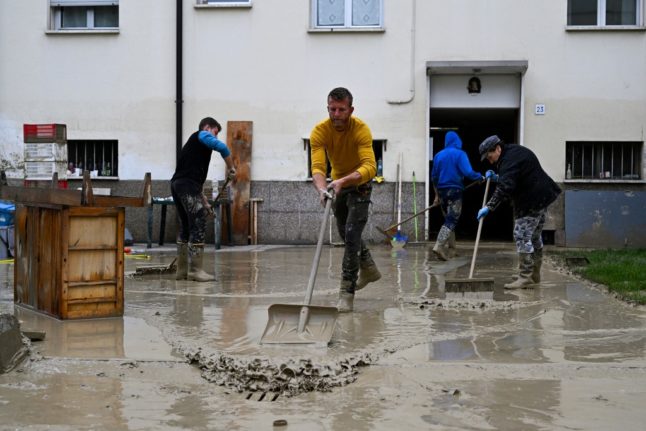Friendship and hot meals for Italy's flood displaced in temporary shelters

Many of the 36,000 people left homeless following deadly flooding in northern Italy are now living in makeshift emergency accommodation, where volunteers say they're trying to make everyone feel welcome.
Ludmilla distracts herself from the memories of rising flood waters by tidying up around her makeshift bed in a gym at Castel Bolognese sheltering some of those who lost their homes.
The 66-year-old has befriended young volunteers, who have agreed to come with her on Sunday to inspect her damaged house in the nearby village of Solarolo and start cleaning up.
READ ALSO: Italy's flood death toll rises to 14 as government urged to act on climate
She doesn't expect to be able to move back in for at least a month though, after devastating floods which pummelled the Emilia Romagna region in northeast Italy this week, leaving 14 people dead.
It happened "without warning," says Ludmilla, who moved to Italy from Ukraine 16 years ago, and who did not want to give her last name.
"They said 'a little bit of water will come, a little bit'," she notes, but she and her 97-year-old husband soon found themselves up to their waists in water.
"My husband said 'I've seen three wars, but I've never seen anything like this'," she adds.

Photo: Andreas SOLARO/AFP.
"We were stuck there, without water, without food. I called the fire brigade, the police.
"They were good people, as are the volunteers here," she says. "There's food, there's everything".
Ludmilla's husband was taken to hospital. She can only wait here for the waters to recede, as volunteers move among the rows of beds, boxes of donated food and essential items.
A few beds away, neighbours Alfonso Brocchi and Iolanda Soglia are going back over what happened.
"At three am, the upstairs neighbour called me and said 'Alfonso, come up, the water is coming'," says Brocchi, 76, who rushed to help Soglia, who has muscular dystrophy.
READ ALSO: Why has flooding in northern Italy been so devastating?
His son had called the fire brigade to get them out, but Brocchi was not sure how to reach them.
"I could get a step ladder and get through the window, but she couldn't," Brocchi says.
"So they (the firemen) said 'open the door'. And when I opened the door it was like a rushing river."
The pair were rescued along with a 102-year-old woman, and taken by the fire brigade to the shelter.
READ ALSO: How you can help people affected by flooding in northern Italy
Other displaced people are expected to arrive in a few hours, but the beds are not only for them.
Volunteers from the civil protection and rescue workers also take the opportunity to grab a few hours sleep between shifts, or wind down over a hot meal.
Some 200 of the 10,000 or so residents in Castel Bolognese were evacuated Monday as a precaution, before the floods hit overnight.
The muddy waters which swept through the streets left a trail of desolation behind.

Volunteers clean mud from a flooded courtyard in Faenza. (Photo by Andreas SOLARO / AFP)
At the entrance to the gym, paper towels, blankets and bags of donated clothes are piled up along the wall in a line which lengthens as the day goes on.
The general hubbub is soothing, lulling the weary to sleep. The shelter team hopes its efforts will help the newly homeless to lead a life as normal as possible.
"After this disaster, it is important that everyone feels at home here," says Paola Barilli, 52, who is in charge of some 60 volunteers.
"Everyone is welcome, even animals", she adds.
And as if to prove her right, among the guests is a family which brought its nine cats along.
Comments
See Also
Ludmilla distracts herself from the memories of rising flood waters by tidying up around her makeshift bed in a gym at Castel Bolognese sheltering some of those who lost their homes.
The 66-year-old has befriended young volunteers, who have agreed to come with her on Sunday to inspect her damaged house in the nearby village of Solarolo and start cleaning up.
READ ALSO: Italy's flood death toll rises to 14 as government urged to act on climate
She doesn't expect to be able to move back in for at least a month though, after devastating floods which pummelled the Emilia Romagna region in northeast Italy this week, leaving 14 people dead.
It happened "without warning," says Ludmilla, who moved to Italy from Ukraine 16 years ago, and who did not want to give her last name.
"They said 'a little bit of water will come, a little bit'," she notes, but she and her 97-year-old husband soon found themselves up to their waists in water.
"My husband said 'I've seen three wars, but I've never seen anything like this'," she adds.

"We were stuck there, without water, without food. I called the fire brigade, the police.
"They were good people, as are the volunteers here," she says. "There's food, there's everything".
Ludmilla's husband was taken to hospital. She can only wait here for the waters to recede, as volunteers move among the rows of beds, boxes of donated food and essential items.
A few beds away, neighbours Alfonso Brocchi and Iolanda Soglia are going back over what happened.
"At three am, the upstairs neighbour called me and said 'Alfonso, come up, the water is coming'," says Brocchi, 76, who rushed to help Soglia, who has muscular dystrophy.
READ ALSO: Why has flooding in northern Italy been so devastating?
His son had called the fire brigade to get them out, but Brocchi was not sure how to reach them.
"I could get a step ladder and get through the window, but she couldn't," Brocchi says.
"So they (the firemen) said 'open the door'. And when I opened the door it was like a rushing river."
The pair were rescued along with a 102-year-old woman, and taken by the fire brigade to the shelter.
READ ALSO: How you can help people affected by flooding in northern Italy
Other displaced people are expected to arrive in a few hours, but the beds are not only for them.
Volunteers from the civil protection and rescue workers also take the opportunity to grab a few hours sleep between shifts, or wind down over a hot meal.
Some 200 of the 10,000 or so residents in Castel Bolognese were evacuated Monday as a precaution, before the floods hit overnight.
The muddy waters which swept through the streets left a trail of desolation behind.

At the entrance to the gym, paper towels, blankets and bags of donated clothes are piled up along the wall in a line which lengthens as the day goes on.
The general hubbub is soothing, lulling the weary to sleep. The shelter team hopes its efforts will help the newly homeless to lead a life as normal as possible.
"After this disaster, it is important that everyone feels at home here," says Paola Barilli, 52, who is in charge of some 60 volunteers.
"Everyone is welcome, even animals", she adds.
And as if to prove her right, among the guests is a family which brought its nine cats along.
Join the conversation in our comments section below. Share your own views and experience and if you have a question or suggestion for our journalists then email us at [email protected].
Please keep comments civil, constructive and on topic – and make sure to read our terms of use before getting involved.
Please log in here to leave a comment.